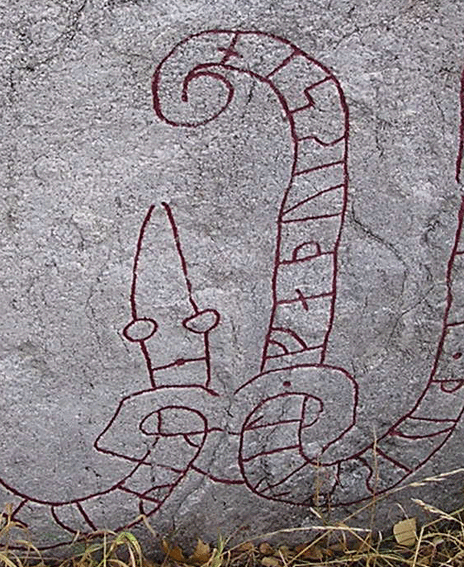
Södermanland Runic Inscription 194
Encyclopedia

Rundata
The Scandinavian Runic-text Data Base is a project involving the creation and maintenance of a database of runic inscriptions. The project's goal is to comprehensively catalog runestones in a machine-readable way for future research...
designation for a runic inscription on a memorial
Memorial
A memorial is an object which serves as a focus for memory of something, usually a person or an event. Popular forms of memorials include landmark objects or art objects such as sculptures, statues or fountains, and even entire parks....
runestone located in Brössike, which is about 12 kilometers northeast of Strängnäs
Strängnäs
Strängnäs is a locality and the seat of Strängnäs Municipality, Södermanland County, Sweden with 12,296 inhabitants in 2005. It is located by Lake Mälaren and is the episcopal see of the Diocese of Strängnäs, a former Roman Catholic and present Lutheran Diocese, with the Strängnäs Cathedral, built...
, Södermanland County
Södermanland County
Södermanland County is a county or län on the south east coast of Sweden. It borders the counties of Östergötland, Örebro, Västmanland, Uppsala, Stockholm and to the Baltic sea....
, Sweden
Sweden
Sweden , officially the Kingdom of Sweden , is a Nordic country on the Scandinavian Peninsula in Northern Europe. Sweden borders with Norway and Finland and is connected to Denmark by a bridge-tunnel across the Öresund....
, which was in the historic province of Södermanland
Södermanland
', sometimes referred to under its Latin form Sudermannia or Sudermania, is a historical province or landskap on the south eastern coast of Sweden. It borders Östergötland, Närke, Västmanland and Uppland. It is also bounded by lake Mälaren and the Baltic sea.In Swedish, the province name is...
. There are many such memorial runestones in Scandinavia
Scandinavia
Scandinavia is a cultural, historical and ethno-linguistic region in northern Europe that includes the three kingdoms of Denmark, Norway and Sweden, characterized by their common ethno-cultural heritage and language. Modern Norway and Sweden proper are situated on the Scandinavian Peninsula,...
. While the tradition of carving inscriptions into boulders began in the 4th century and lasted into the 12th century, most runestones date from the late Viking Age
Viking Age
Viking Age is the term for the period in European history, especially Northern European and Scandinavian history, spanning the late 8th to 11th centuries. Scandinavian Vikings explored Europe by its oceans and rivers through trade and warfare. The Vikings also reached Iceland, Greenland,...
.
Description
Carved into a granite boulder that is 1.4 meters in height, this unsigned inscription has been attributed to the runemasterRunemaster
A runemaster or runecarver is a specialist in making runestones.Most early medieval Scandinavians were probably literate in runes, and most people probably carved messages on pieces of bone and wood. However, it was difficult to make runestones, and in order to master it one also needed to be a...
Balle
Balle (runemaster)
Balle or Red-Balle was a runemaster who was active in the areas of western Uppland, Västmanland, and northern Södermanland of Sweden during the second half of the 11th century.-Work:...
, who was active during the last half of the eleventh century. The text of the inscription lies within a serpent band, a motif common on many memorial runestones. At the bottom of the inscription, there is a binding around the head and tail of the serpent as if to keep the serpent bound to the surface of the stone. The runestone is classified as being carved in runestone style Fp. This is the classification for inscriptions with runic bands that end with serpent or animal heads depicted as seen from above.
The runic text states that the stone was raised by two sons named Ingimundr and Þjalfi in memory of their father Þorketill. The Old Norse name Ingimundr means "Tutelage of Youth." Þjalfi means "Digger" or "Delver," and Þjálfi
Þjálfi and Röskva
In Norse mythology, Þjálfi and Röskva are two siblings, male and female respectively, who are servants of the god Thor. Þjálfi receives a single mention in the Poetic Edda, compiled in the 13th century from earlier traditional material, while both Þjálfi and Röskva are attested in the Prose Edda,...
was the name of a servant or follower of the Norse god Thor
Thor
In Norse mythology, Thor is a hammer-wielding god associated with thunder, lightning, storms, oak trees, strength, the protection of mankind, and also hallowing, healing, and fertility...
that is listed in the Prose Edda
Prose Edda
The Prose Edda, also known as the Younger Edda, Snorri's Edda or simply Edda, is an Icelandic collection of four sections interspersed with excerpts from earlier skaldic and Eddic poetry containing tales from Nordic mythology...
. The name Þorketil signifies a "Vessel or Kettle of Thor," possibly a type of sacrificial cauldron. The Poetic Edda
Poetic Edda
The Poetic Edda is a collection of Old Norse poems primarily preserved in the Icelandic mediaeval manuscript Codex Regius. Along with Snorri Sturluson's Prose Edda, the Poetic Edda is the most important extant source on Norse mythology and Germanic heroic legends, and from the early 19th century...
poem Hymiskviða
Hymiskviða
Hymiskviða is a poem collected in the Poetic Edda. Its contents are somewhat confusing but can be summarized more or less as follows....
has a story in which Thor fetches a large cauldron to brew ale.
Transliteration of the runes into Latin characters
- ekimunr * auk * þalfi * þir * ristu * stin * þina * at * þurktil * faþur sin
Transcription into Old Norse
- Ingimundr ok Þjalfi þeir reistu stein þenna at Þorketil, fôður sinn.
Translation in English
- Ingimundr and Þjalfi, they raised this stone in memory of Þorketill, their father.

